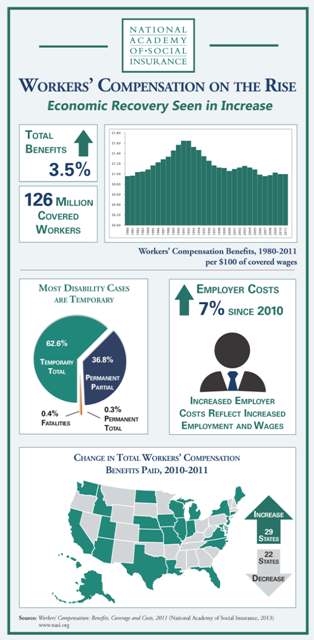Workers' Compensation Benefits, Employer Costs Rise Across U.S., Down in Georgia
Press release from the issuing company
Wednesday, August 21st, 2013
After declining in the wake of the recession, workers’ compensation benefits paid to injured workers and costs borne by employers increased in 2011 as the U.S. economy continued to recover, according to a new report by the National Academy of Social Insurance (NASI).
Total benefits rose by 3.5 percent to $60.2 billion. The benefits include a 4.5 percent rise in medical care spending to $29.9 billion and a 2.6 percent rise in wage replacement benefits to $30.3 billion. Total costs to employers rose by 7.1 percent to $77.1 billion.
"Workers’ compensation often grows with the growth in employment and earnings,” said Marjorie Baldwin, chair of NASI’s Workers’ Compensation Data Panel and Professor of Economics in the W.P. Carey School of Business at Arizona State University. When benefits and costs are measured relative to total covered wages, then benefits remained unchanged, and costs to employers rose very modestly (to $1.27 per $100 of wages) after declining in the previous five years.
The new report shows changes in coverage, benefits, and employer costs for all 50 states and the District of Columbia. State-level changes in 2011 include:
- Coverage and wages increased in all 50 states and the District of Columbia.
- Total benefits paid to injured workers increased in 29 jurisdictions. However, benefits as a percent of total wages increased in only 17.
- Employers’ costs of workers’ compensation as a percent of total wages increased in 31 states, and remained unchanged in four.
- The share of benefits paid for medical care exceeded 50 percent in 33 states.



